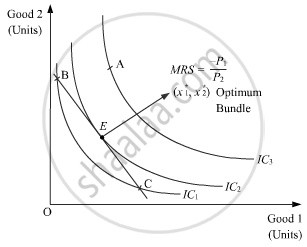Advertisements
Advertisements
Question
"For a consumer to be in the equilibrium position, a marginal rate of substitution between the two goods must be equal to the ratio of prices of the two goods." Do you agree with the given statement? Justify your answer.
Solution
Yes, we agree with the statement that "For a consumer to be in the equilibrium position, the marginal rate of substitution between the two goods must be equal to the ratio of prices of the two goods".
A consumer always aims at maximising his/her utility or satisfaction level. A rational consumer, with well-defined preferences, will always choose the best bundle among all the bundles available to him, given his/her money income and the prices of the goods and services. In other words, a consumer always tries to attain the highest possible IC given his/her budget set. The consumption bundles that lie below the budget line leave the consumer with some unspent income. As compared to this the consumption bundles that lie on the budget line will have more of at least one of the goods and no less of the other. In other words, the consumption bundles that lie on the budget line will be more preferred than those that lie below the budget line. As against this, the consumption bundles that lie above the budget line are unaffordable (i.e. the consumer cannot purchase those bundles with his given money income).
From this analysis, it can be inferred that the optimum bundle for the consumer must lie on the budget line.
A consumer attains equilibrium at the point where the budget line is tangent to the indifference curve. This optimum point is characterised by the following equality.
The slope of the IC = Slope of the budget line
`|-d"y"|/|d"x"| = |"MRS"| = |-"P"_1|/|"P"_2|`
The absolute value of the slope of the IC = Absolute value of the slope of the budget line
Graphically, the equilibrium can be depicted as follows.

APPEARS IN
RELATED QUESTIONS
A consumer consumes only two goods. Explain consumer's equilibrium with the help of utility analysis.
Explain the condition of consumer's equilibrium with the help of utility analysis.
A consumer consumes only two goods X and Y. Marginal utilities of X and Y is 3 and 4 respectively. Prices of X and Y are Rs 4 per unit each. Is consumer in equilibrium? What will be further reaction of the consumer? Give reasons.
A consumer consumes only two goods X and Y. Marginal utilities of X and Y are 4 and 3 respectively. Price of X and price of Y is Rs 3 per unit. Is consumer in equilibrium? What will be further reaction of the consumer? Give reasons.
A consumer consumes only two goods X and Y. The marginal utilities of X and of Y is 3. Prices of X and Y are Rs 2 and Rs 1 respectively. Is consumer in equilibrium? What will be further reaction of the consumer?
Give reasons.
A consumer consumes only two goods X and Y. If marginal utilities of X and Y are 4 and 5 respectively, and if price of X is Rs 5 per unit and that of Y is Rs 4 per unit is the consumer in equilibrium? What will be further reaction of the consumer? Explain.
A consumer consumes only two goods X and Y. Marginal utility of each is 2. The price per unit of X and Y is Re 1 and Rs 2 respectively. Is the consumer in equilibrium? What will be the further reaction of the consumer? Explain.
A consumer consumes only two goods X and Y and is in equilibrium. Price of X falls. Explain the reaction of the consumer through the Utility Analysis.
Should the following be treated as final expenditure or intermediate expenditure? Give reasons for your answer.
(i) Purchase of furniture by a firm.
(ii) Expenditure on maintenance by a firm.
What is meant by producer’s equilibrium? Explain the conditions of producer’s equilibrium through the ‘total revenue and total cost’ approach. Use diagram.
Answer the following question.
Explain with the help of a diagram the consumer’s equilibrium through utility approach.
